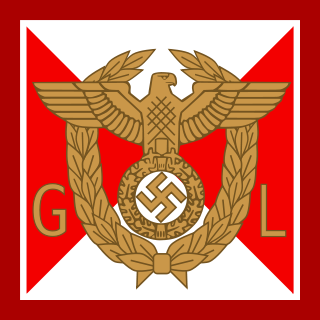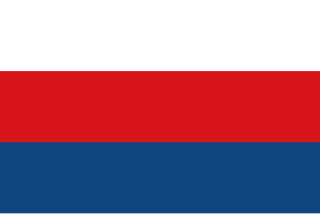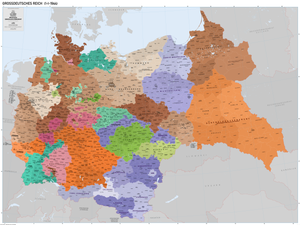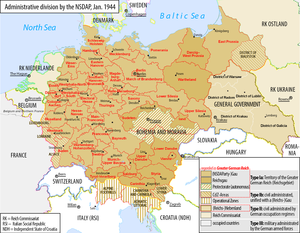
The Reichsgau Wartheland was a Nazi German Reichsgau formed from parts of Polish territory annexed in 1939 during World War II. It comprised the region of Greater Poland and adjacent areas. Parts of Warthegau matched the similarly named pre-Versailles Prussian province of Posen. The name was initially derived from the capital city, Posen (Poznań), and later from the main river, Warthe (Warta).

A Gauleiter was a regional leader of the Nazi Party (NSDAP) who served as the head of a Gau or Reichsgau. Gauleiter was the third-highest rank in the Nazi political leadership, subordinate only to Reichsleiter and to the Führer himself. The position was effectively abolished with the fall of the Nazi regime on 8 May 1945.

Reichsgau Danzig-West Prussia was an administrative division of Nazi Germany created on 8 October 1939 from annexed territory of the Free City of Danzig, the Greater Pomeranian Voivodship, and the Regierungsbezirk West Prussia of Gau East Prussia.

The Protectorate of Bohemia and Moravia was a partially-annexed territory of Nazi Germany that was established on 16 March 1939 after the German occupation of the Czech lands. The protectorate's population was mostly ethnic Czech.

Ostmark was a name that referred historically to the Margraviate of Austria, a medieval frontier march. It was also used in Nazi propaganda from 1938 to 1942 to refer to the formerly independent Federal State of Austria after the Anschluss with Nazi Germany. From the Anschluss until 1939, the official name used was Land Österreich.

A Reichsgau was an administrative subdivision created in a number of areas annexed by Nazi Germany between 1938 and 1945.

Gau is a Germanic term for a region within a country, often a former or current province. It was used in the Middle Ages, when it can be seen as roughly corresponding to an English shire. The administrative use of the term was revived as a subdivision during the period of Nazi Germany in 1933–1945. It still appears today in regional names, such as the Rheingau or Allgäu.

Joseph Bürckel was a German Nazi politician and a member of the German parliament. He was an early member of the Nazi Party and was influential in the rise of the National Socialist movement. He played a central role in the German acquisition of the Saarland and Austria. He held the posts of Gauleiter and Reichsstatthalter in both Gau Westmark and Reichsgau Vienna.

Gau Swabia, formed on 1 October 1928, was an administrative division of Nazi Germany in Swabia, Bavaria, from 1933 to 1945. From 1928 to 1933, it was the regional subdivision of the Nazi Party in that area.

The States of the Weimar Republic were the first-level administrative divisions and constituent states of the German Reich during the Weimar Republic era. The states were established in 1918 following the German Revolution upon the conclusion of World War I, and based on the 22 constituent states of the German Empire that abolished their local monarchies. The new states continued as republics alongside the three pre-existing republican city-states within the new Weimar Republic, adopting the titles Freistaat or Volksstaat.

The Reichsgau Styria was an administrative division of Nazi Germany consisting of areas in Styria, Lower Styria and southern parts of Burgenland. It existed from 1938 to 1945.

The Reichsgau Carinthia was an administrative division of Nazi Germany in Carinthia and East Tyrol and Upper Carniola in Slovenia. It existed from 1938 to 1945.

The Reichsgau Upper Danube was an administrative division of Nazi Germany, created after the Anschluss in 1938 and dissolved in 1945. It consisted of what is today Upper Austria, parts of Southern Bohemia, and a small part of the Salzkammergut which was annexed from Styria.

The Reichsgau Vienna was an administrative division of Nazi Germany based in Vienna, Austria. It existed between 1938 and 1945. Parts of Lower Austria were annexed to establish Greater Vienna, which then became the biggest city of Nazi Germany by area.

The Reichsgau Lower Danube was an administrative division of Nazi Germany consisting of areas in Lower Austria, Burgenland, southeastern parts of Bohemia, southern parts of Moravia, later expanded with Devín and Petržalka. It existed between 1938 and 1945.

The Reichsgau Tyrol-Vorarlberg was an administrative division of Nazi Germany consisting of Vorarlberg and North Tyrol. It existed from 1938 to 1945. It did not include East Tyrol (Lienz), which was instead part of Reichsgau Carinthia.

The Reichsgau Salzburg was an administrative division of Nazi Germany in Salzburg, Austria. It existed between 1938 and 1945.

The Reichsgau Sudetenland was an administrative division of Nazi Germany from 1939 to 1945. It comprised the northern part of the Sudetenland territory, which was annexed from Czechoslovakia according to the 30 September 1938 Munich Agreement. The Reichsgau was headed by the former Sudeten German Party leader, now Nazi Party functionary Konrad Henlein as Gauleiter and Reichsstatthalter. From October 1938 to May 1939, it was the regional subdivision of the Nazi Party in that area, also under Henlein's leadership. The administrative capital was Reichenberg (Liberec).

Chief of Civil Administration was an office introduced in Nazi Germany, operational during World War II. Its task was to administer civil issues according to occupation law, with the primary purpose being the support of the military command in the operational areas of the German Army. CdZ would pass his authority to a corresponding civil government after the territory in question became in the rear of the operating armed forces.















